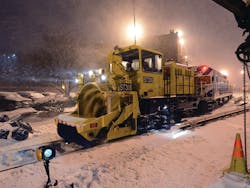An army of MTA New York City Transit workers swept throughout the city and waged a war of attrition against the first winter storm of 2014. As a result of their hard work, the system’s subways and buses continued to operate, though with service changes necessitated by the harsh weather conditions.
“Everything was done with the strongest focus on safety possible, for our customers and employees,” said NYC Transit President Carmen Bianco. “We have procedures in place to address these weather conditions and they have been fine-tuned over decades of operation. Of course, we have an extremely dedicated workforce out there putting those plans into action.”
The storm watch began days prior to the Thursday night/Friday morning weather event as transit managers tracked the weather’s progress and prepared the tools necessary to preserve service. Snow-throwing and deicing equipment were readied by the Department of Subways while Department of Buses personnel chained buses and prepared salt spreading equipment. Maintenance workers were assigned to 12-hour shifts to confront the first storm of the new year, which featured heavy, blowing snow and blisteringly cold temperatures that taxed equipment and workers alike.
Throughout the night, subway trains operated in local-only service as cars not required for overnight service were stored underground on express tracks to ensure their availability for rush hour service. Even after the weather cleared, one of the more challenging jobs was the clearing of the subway system’s 14 outdoor storage yards. This would have been a far more difficult chore had trains been parked in their normal storage facilities.
Along the lines, the snow throwers were deployed throughout the storm along vulnerable portions of the system such as the Bronx’ Dyre Avenue Line, the Rockaways in Queens and the Sea Beach Line in Brooklyn. De-icing trains rolled along the outdoor lines applying a solution to prevent the third rail from icing up.
Special attention was paid to the system’s 16 million square feet of station flooring with a force of more than 1,000 workers shoveling and treating platforms and stairways to keep them safe for customers, who were, of course, advised to walk carefully.
A portion of the subway fleet on lines that travel outdoors and all Staten Island Railway trains operated with special scraper shoes to help prevent ice build up on the electrified third rail. Ice on the third rail can cause an interruption of electrical power resulting in stalled trains.
Out on the streets, the Department of Buses chained upwards of 3,400 buses. Limited service was suspended along those routes and to the extent possible, articulated buses were swapped out of service in favor of 40-foot buses, which handle better in the snow. Particular attention was paid to routes with hilly sections and some bus routes were either put on detour or suspended while road surfaces were cleared.
Work to bring the system back to normal continued over the next few days, forcing the suspension of a majority of weekend maintenance work. This week began with further challenges as melting snow and subsequent freezing temperatures will require the Department of Subways to clear outdoor portions of the system of ice.
More images available on the MTA Flickr page.



